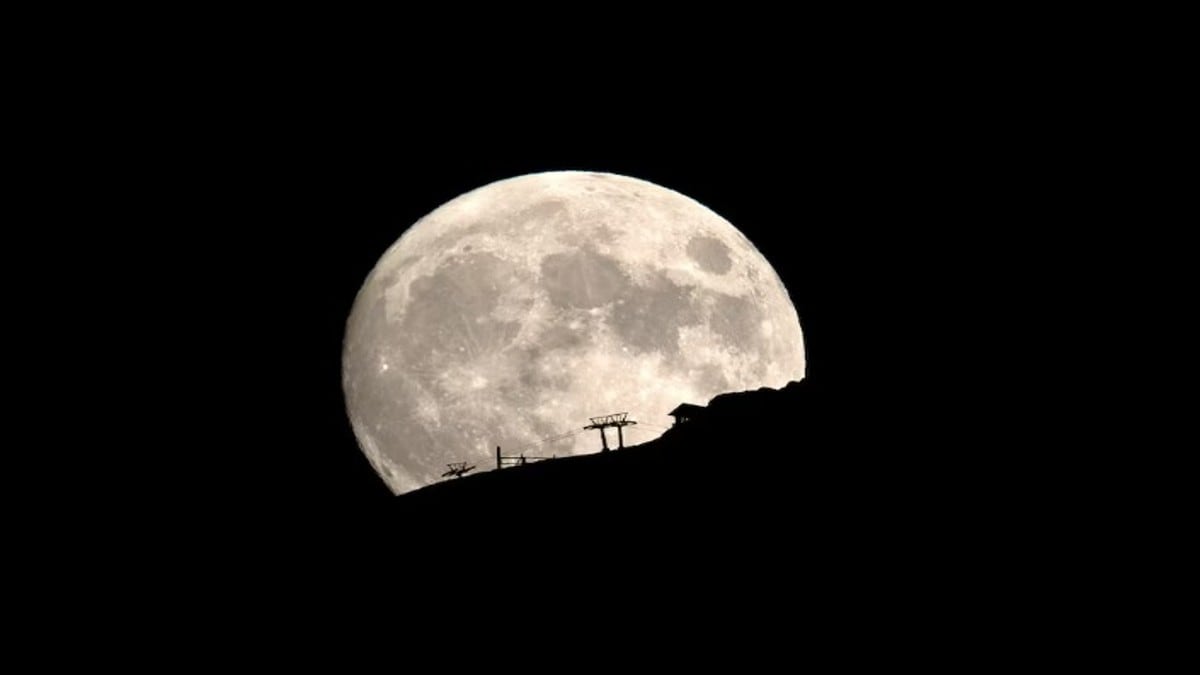
Russia and China are teaming up to set up a nuclear power station on the lunar surface. The primary motivation behind this project is to provide a reliable power source for future lunar bases. This ambitious project is led by Russia’s state nuclear corporation, Rosatom.
The small nuclear reactor on the Moon will be capable of generating up to half a megawatt of energy. That should be sufficient for most scientific apparatus being operated on the moon and also for a small human accommodation. More importantly, it will have many years of life and will operate even when there is no solar energy on the dark side of the moon for nearly half the month.

Russia’s Roscosmos and China’s China National Space Administration (CNSA) have already signed a memorandum of understanding (MoU). There is also a proposal that India should be part of such a project, and on a lighter note, called the Putin-Xi-Modi nuclear project. Rosatom chief Alexey Likhachev has been quoted by TASS, saying, “China and India are eager to be involved in creating this ground-breaking lunar energy solution.
We are trying to lay the foundation for several international space projects.” It is time to understand the dynamics of Small Modular Reactors (SMR). Russia China MoU In March 2021, Russia’s Roscosmos and China’s CNSA signed a memorandum of understanding to collaborate on the International Lunar Research Station (ILRS).
As part of the project, China has plans to launch three missions—Chang’e 6, Chang’e 7, and Chang’e 8—to test mandatory technologies that will be required for setting up a robotic base for remote experiments. The first mission is planned for 2026, with project completion expected by 2028. It could then be a precursor for setting up a human habitation a few decades down the line.
When India joins, the three countries will pool in financial and technological resources and share the risks. All three have fairly successful nuclear and space programmes having successfully mastered most relevant technologies. Currently, Russia targets to deploy the reactor by 2036.
India’s plans were to set up a lunar base by around 2050. A nuclear reactor will be the first step for a space base. More nations could come on board as it goes along.
US Space Base Plan The US has an independent programme for space bases. In 2028, NASA plans on launching the Lunar Surface Asset, a small habitat to the surface of the Moon, on either an SLS Block 1B or through an Artemis Support Mission on a commercial launcher. This would be the first crewed lunar base.
The Artemis crewed spaceflight programme will be carried out predominantly by NASA, US commercial spaceflight companies, and international partners such as the European Space Agency (ESA), Japan’s JAXA, and the Canadian Space Agency (CSA) with the goal of landing “the first woman and the next man” on the Moon, specifically at the lunar south pole region by 2026. NASA sees Artemis as the next step towards the long-term goal of establishing a sustainable presence on the Moon, laying the foundation for private companies to build a lunar economy, and eventually sending humans to Mars. The US-led Artemis Programme has scheduled several crewed landings, starting with Artemis 3 tentatively planned for 2026 and thereafter setting up five temporary base camps with the Human Landing Systems (HLS) until Artemis 8 is planned to set up the fixed Foundational Surface Habitat (FSH) of the Artemis Base Camp in the 2030s.
India is the 27th country to sign the Artemis Accords. Early Small Nuclear Reactors for Submarines The design, development, and production of nuclear marine propulsion plants started in the United States in the 1940s. The United States and Soviet Union have had nuclear-powered submarines since the early 1950s.
The nuclear submarine is powered by a small nuclear reactor. The nuclear propulsion being independent of air frees the nuclear submarines from having to surface frequently, as required by the diesel-electric-powered submarines. The much more efficient power generation allows higher speeds.
The submarine may not be refuelled for an entire operational life of typically around 25 years. Interestingly, even with the most advanced electric batteries, a modern conventional diesel submarine may remain submerged for a few days at slow speed and only a few hours at top speed. Marine-type reactors differ from land-based commercial electric power reactors in several respects.
Nuclear Powered Ships and Vessels Only the United States and France built nuclear aircraft carriers. The Soviet Union had a heavy nuclear-powered guided missile cruiser. The United States Navy (USN) also built similar cruisers, but all were retired before the year 2000.
Russia has nuclear-powered and nuclear-armed unmanned underwater vehicles. In the 1960s, the US built a few experimental nuclear-powered civil merchant ships but did not pursue them as they were too small and expensive to operate economically. The 1988-built Russian vessel “Sevmorput” is one of only four nuclear-powered merchant ships ever built.
After refurbishment in 2016, currently it is the only one in service in the world. The Soviet Union and now Russia have been using nuclear-powered icebreaker ships since the late 1950s. A few are still in service, and more are being built.
The high cost of nuclear technology and maintenance means that very few military powers can afford nuclear submarines or ships. In 2020, the Pentagon issued contracts for mobile, small nuclear reactors that will provide nuclear power for American forces at home and abroad. Small Nuclear Power Reactors The International Atomic Energy Agency (IAEA) defines ‘small’ as under 300 MWe and up to about 700 MWe as ‘medium’.
Small portable nuclear power reactors are required both military and civilian for use in remote locations. While small reactors require special technologies, they are less cost-intensive, especially for transmission. Experience from nuclear-powered submarines already exists, and therefore the challenges are fewer.
Greater demand would also mean economy of scale. Modern small reactors are being designed to be modular. There are also very small units, which are about 15 MWe, especially for remote communities.
Four types of small reactors that are evolving include light water reactors, fast neutron reactors, graphite-moderated high temperature reactors, and a few types of molten salt reactors. In the end, what matters is the smaller size, low technology risk, inherent safety, and longer unrefueled operations. Smaller reactors also require much less real estate.
Another advantage of small reactors is the much lesser safety zone radius around them. They use low-enriched uranium (LEU) and require much less cooling water. They also produce lower radioactivity.
Lower investment and sitting costs make them more attractive, even for captive corporate use. Decommissioning of such plants is much simpler. Yes, certification and licensing have issues.
These reactors will also be well suited for very small countries or island nations. Arctic regions are also contenders for SMR. SMRs can be fabricated at a plant and then moved to the installation site.
This saves time and on-site activity. Also, the overall cost is much lower because of standardisation and production scale. Modularity and commonality in design also hasten licensing.
Additional modules can be added if the power requirement needs to be scaled up. Reverse could be true in the case of a scale-down of demand. A smaller reactor also reduces safety concerns, and containment in case of accident is easier.
SMRs also have a greater variety of cooling options. In the case of SMR, the thermal energy can be used directly without conversion, like heating water, etc. Most SMRs can run without much supervision.
Many SMRs have higher fuel burnup, reducing the quantity of waste. The initial setting up cost of the SMR manufacturing plants is fairly high, and therefore, to reduce the amortised cost, there may be a need to produce around 50 or more SMRs. Nuclear proliferation risk remains a concern for SMRs.
Significantly reduced staffing reduces physical protection and therefore increases security concerns. Countries Working on SMR In the US, Westinghouse, Babcock & Wilcox, Holtec, and NuScale Power are some of the major players. China has some of the most advanced SMRs.
China is also developing small district-level heating reactors to replace coal-based heating plants in northern parts. India’s 220 MWe pressurised heavy water reactors (PHWRs) are also SMR. The Nuclear Power Corporation of India (NPCIL) is offering both 220 and 540 MWe versions internationally.
The Chinese 300-325 MWe PWR at Chashma in Pakistan (called CNP-300) is an SMR. The UK, Canada, Russia, Japan, South Korea, Denmark, and South Africa are also other players. Mini Nuclear Plants for Military For a long time, the US Army has been using mobile and static small reactors to power remote air/missile defence radar stations in Alaska, Greenland, and Antarctica and for providing electricity and heating.
Mini Nuclear Power Plants (MNPP) would be portable and operate unrefueled for 10-20 years. Mobile SMRs would be ideal for rapid response scenarios. These would also be handy during humanitarian assistance and disaster relief (HADR) operations.
The smaller ones could generate below 10 MWe for at least three years without refuelling, weigh less than 40 tonnes, and have volume less than enough to move on a truck, ship, or C-17 aircraft. US DoD’s “Project Pele” is on track for full-power outdoor testing of a prototype mobile reactor in 2024. It will be ready for delivery by 2025.
The project was listed as also relevant to lunar and Mars surface operations. During the Soviet Union, Pamir-630D truck-mounted small air-cooled 0.6 MWe nuclear reactors were built.
These were discontinued later. Russia now has small transportable 2.5 MWe nuclear reactors.
Russia is also developing small mobile nuclear power plants for the military in the Arctic air transportable by IL-76 aircraft and Mi-26 helicopters. Super small radioisotope thermoelectric generators were considered the answer. NASA reportedly uses some of these to power satellites and other spacecraft.
In 2020, the Pentagon awarded three contracts for mobile small nuclear reactors. The 2-10 MWe range, small reactors could be available by 2024. They could be deployable by 2027.
Security during the move of the reactor would have to be very high. Nuclear Propulsion for Satellites Nuclear power is being used in space for electricity and heat generation in extreme cold temperatures. Radioisotope thermoelectric generators have been used in long-distance space probes and on crewed lunar missions.
Both the US and USSR had sent many nuclear-electric satellites into space. The more powerful TOPAZ-II reactor could produce 10 kilowatts of electricity. Nuclear power for space propulsion systems using ion thrusters greatly reduces the satellite size and options for alternative payloads.
Also, propulsion is required to regain the drifted satellite’s position or to avoid collisions. New systems are under development. Way Ahead India Clearly, while environmental concerns are driving the switch from fossil fuel power generation to much cleaner alternative energy for electric power generation for civil use, the military and space need much smaller, lighter, and longer-lasting power sources for better mobility and at remote locations, including for planetary habitats.
India has a well-established nuclear energy program. India has the third largest armed forces and very active borders spanning some of the highest mountains and remote jungles. Like the other major powers, Indian armed forces require small nuclear power plants for use on the move.
India’s nuclear submarine program is still evolving, and India has yet to begin developing a nuclear-powered aircraft carrier. Whether India—a part of the Artemis program—can also be a part of Russo-Chinese joint space habitat remains to be seen; however, the technological potential is huge and promising, and it is time for India to get going. The writer is former Director General, Centre for Air Power Studies.
Views expressed in the above piece are personal and solely those of the author. They do not necessarily reflect Firstpost’s views..














